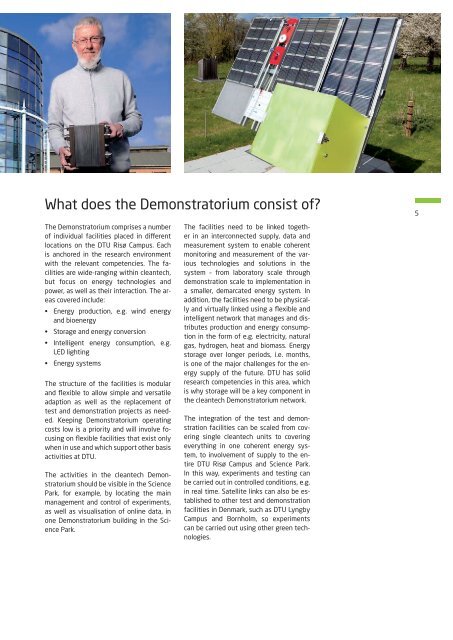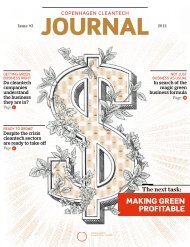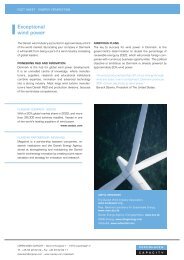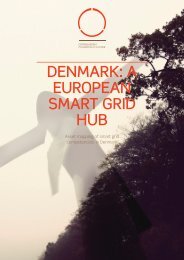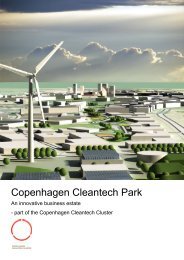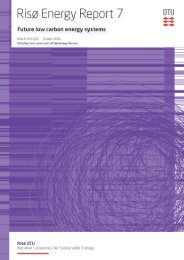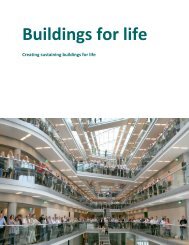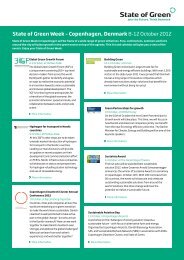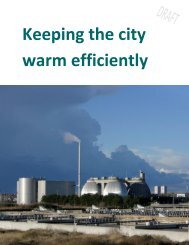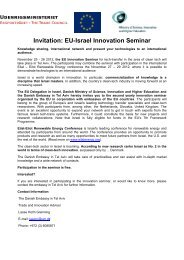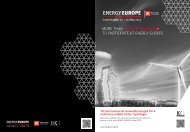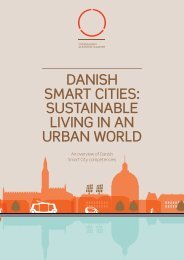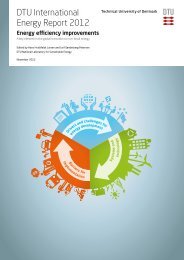Read more about the Cleantech Demonstratorium here
Read more about the Cleantech Demonstratorium here
Read more about the Cleantech Demonstratorium here
Create successful ePaper yourself
Turn your PDF publications into a flip-book with our unique Google optimized e-Paper software.
What does <strong>the</strong> <strong>Demonstratorium</strong> consist of?<br />
5<br />
The <strong>Demonstratorium</strong> comprises a number<br />
of individual facilities placed in different<br />
locations on <strong>the</strong> DTU Risø Campus. Each<br />
is anchored in <strong>the</strong> research environment<br />
with <strong>the</strong> relevant competencies. The facilities<br />
are wide-ranging within cleantech,<br />
but focus on energy technologies and<br />
power, as well as <strong>the</strong>ir interaction. The areas<br />
covered include:<br />
• Energy production, e.g. wind energy<br />
and bioenergy<br />
• Storage and energy conversion<br />
• Intelligent energy consumption, e.g.<br />
LED lighting<br />
• Energy systems<br />
The structure of <strong>the</strong> facilities is modular<br />
and flexible to allow simple and versatile<br />
adaption as well as <strong>the</strong> replacement of<br />
test and demonstration projects as needed.<br />
Keeping <strong>Demonstratorium</strong> operating<br />
costs low is a priority and will involve focusing<br />
on flexible facilities that exist only<br />
when in use and which support o<strong>the</strong>r basis<br />
activities at DTU.<br />
The activities in <strong>the</strong> cleantech <strong>Demonstratorium</strong><br />
should be visible in <strong>the</strong> Science<br />
Park, for example, by locating <strong>the</strong> main<br />
management and control of experiments,<br />
as well as visualisation of online data, in<br />
one <strong>Demonstratorium</strong> building in <strong>the</strong> Science<br />
Park.<br />
The facilities need to be linked toge<strong>the</strong>r<br />
in an interconnected supply, data and<br />
measurement system to enable co<strong>here</strong>nt<br />
monitoring and measurement of <strong>the</strong> various<br />
technologies and solutions in <strong>the</strong><br />
system – from laboratory scale through<br />
demonstration scale to implementation in<br />
a smaller, demarcated energy system. In<br />
addition, <strong>the</strong> facilities need to be physically<br />
and virtually linked using a flexible and<br />
intelligent network that manages and distributes<br />
production and energy consumption<br />
in <strong>the</strong> form of e.g. electricity, natural<br />
gas, hydrogen, heat and biomass. Energy<br />
storage over longer periods, i.e. months,<br />
is one of <strong>the</strong> major challenges for <strong>the</strong> energy<br />
supply of <strong>the</strong> future. DTU has solid<br />
research competencies in this area, which<br />
is why storage will be a key component in<br />
<strong>the</strong> cleantech <strong>Demonstratorium</strong> network.<br />
The integration of <strong>the</strong> test and demonstration<br />
facilities can be scaled from covering<br />
single cleantech units to covering<br />
everything in one co<strong>here</strong>nt energy system,<br />
to involvement of supply to <strong>the</strong> entire<br />
DTU Risø Campus and Science Park.<br />
In this way, experiments and testing can<br />
be carried out in controlled conditions, e.g.<br />
in real time. Satellite links can also be established<br />
to o<strong>the</strong>r test and demonstration<br />
facilities in Denmark, such as DTU Lyngby<br />
Campus and Bornholm, so experiments<br />
can be carried out using o<strong>the</strong>r green technologies.


